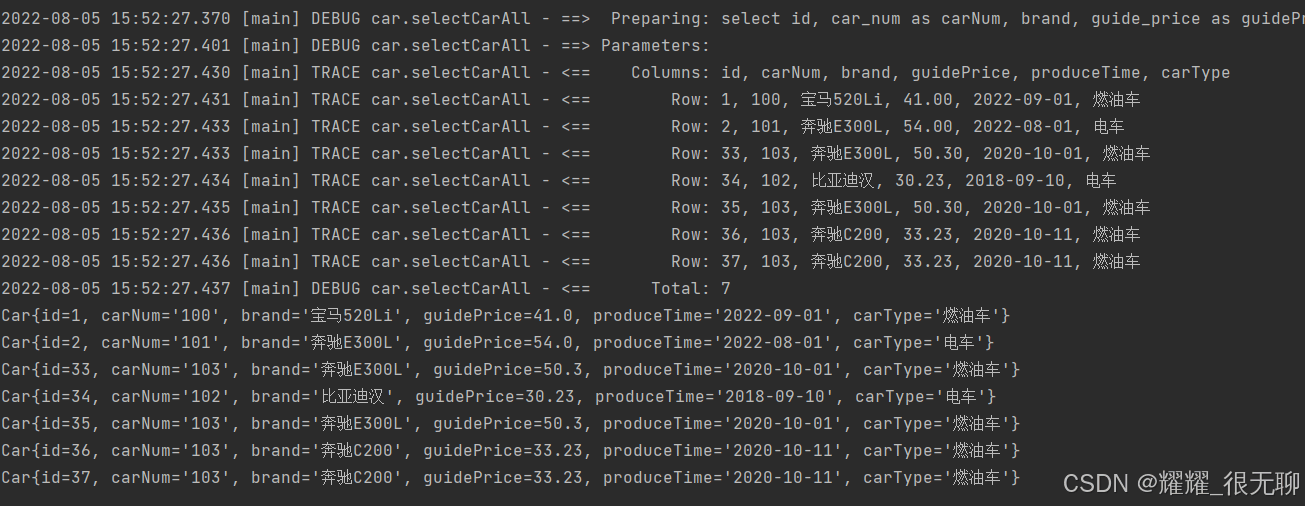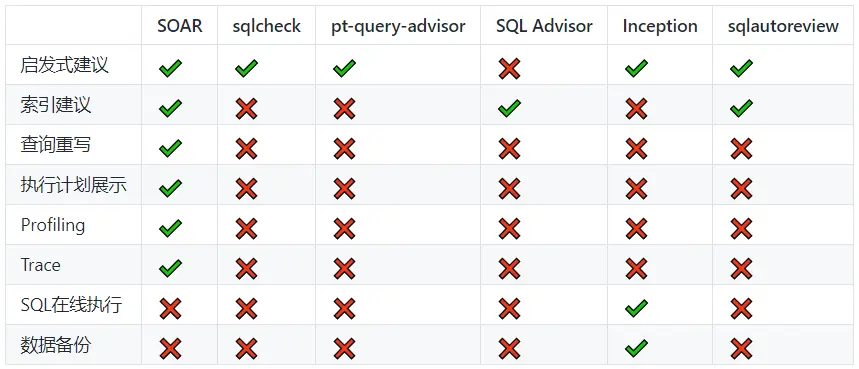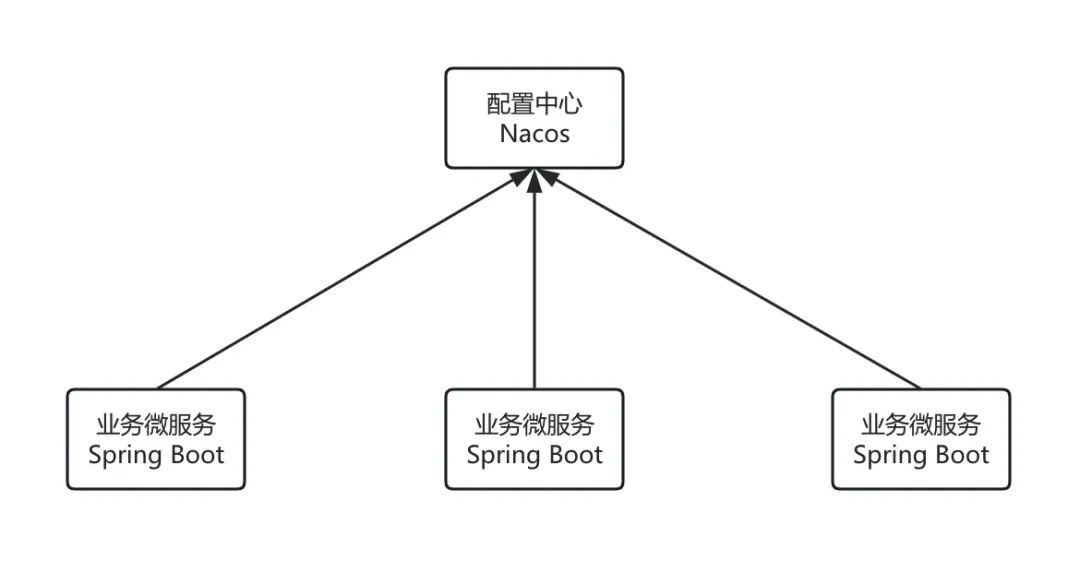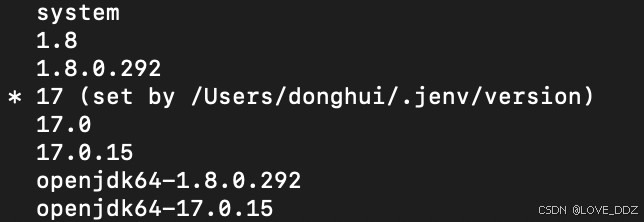准备工作
创建module(Maven的普通Java模块):mybatis-002-crud
pom.xml
- 打包方式jar
- 依赖:
- mybatis依赖
- mysql驱动依赖
- junit依赖
- logback依赖
- mybatis-config.xml放在类的根路径下
- CarMapper.xml放在类的根路径下
- logback.xml放在类的根路径下
- 提供com.study.mybatis.utils.SqlSessionUtil工具类
- 创建测试用例:com.study.mybatis.CarMapperTest
1 insert(Create)
分析以下SQL映射文件中SQL语句存在的问题
|
1 2 3 4 5 6 7 8 9 10 11 |
<?xml version="1.0" encoding="UTF-8" ?> <!DOCTYPE mapper PUBLIC "-//mybatis.org//DTD Mapper 3.0//EN" "http://mybatis.org/dtd/mybatis-3-mapper.dtd">
<!--namespace先随便写--> <mapper namespace="car"> <insert id="insertCar"> insert into t_car(car_num, brand, guide_price, produce_time, car_type) values ('103', '奔驰E300L', 50.3, '2022-01-01', '燃油车') </insert> </mapper> |
存在的问题是:SQL语句中的值不应该写死,值应该是用户提供的。之前的JDBC代码是这样写的:
|
1 2 3 4 5 6 7 8 9 |
// JDBC中使用 ? 作为占位符。那么MyBatis中会使用什么作为占位符呢? String sql = "insert into t_car(car_num,brand,guide_price,produce_time,car_type) values(?,?,?,?,?)"; // ...... // 给 ? 传值。那么MyBatis中应该怎么传值呢? ps.setString(1,"103"); ps.setString(2,"奔驰E300L"); ps.setDouble(3,50.3); ps.setString(4,"2022-01-01"); ps.setString(5,"燃油车"); |
在MyBatis中可以这样做:
在Java程序中,将数据放到Map集合中在sql语句中使用 #{map集合的key} 来完成传值,#{} 等同于JDBC中的 ? ,#{}就是占位符Java程序这样写:
|
1 2 3 4 5 6 7 8 9 10 11 12 13 14 15 16 17 18 19 20 21 22 23 24 25 26 27 28 29 30 31 32 |
package com.study.mybatis;
import com.study.mybatis.utils.SqlSessionUtil; import org.apache.ibatis.session.SqlSession; import org.junit.Test;
import java.util.HashMap; import java.util.Map;
/** * 测试MyBatis的CRUD * @author sqnugy * @version 1.0 * @since 1.0 */ public class CarMapperTest { @Test public void testInsertCar(){ // 准备数据 Map<String, Object> map = new HashMap<>(); map.put("k1", "103"); map.put("k2", "奔驰E300L"); map.put("k3", 50.3); map.put("k4", "2020-10-01"); map.put("k5", "燃油车"); // 获取SqlSession对象 SqlSession sqlSession = SqlSessionUtil.openSession(); // 执行SQL语句(使用map集合给sql语句传递数据) int count = sqlSession.insert("insertCar", map); System.out.println("插入了几条记录:" + count); } } |
SQL语句这样写:
|
1 2 3 4 5 6 7 8 9 10 11 |
<?xml version="1.0" encoding="UTF-8" ?> <!DOCTYPE mapper PUBLIC "-//mybatis.org//DTD Mapper 3.0//EN" "http://mybatis.org/dtd/mybatis-3-mapper.dtd">
<!--namespace先随便写--> <mapper namespace="car"> <insert id="insertCar"> insert into t_car(car_num,brand,guide_price,produce_time,car_type) values(#{k1},#{k2},#{k3},#{k4},#{k5}) </insert> </mapper> |
**#{} 的里面必须填写map集合的key,不能随便写。**运行测试程序,查看数据库:

如果#{}里写的是map集合中不存在的key会有什么问题?
|
1 2 3 4 5 6 7 8 9 10 |
<?xml version="1.0" encoding="UTF-8" ?> <!DOCTYPE mapper PUBLIC "-//mybatis.org//DTD Mapper 3.0//EN" "http://mybatis.org/dtd/mybatis-3-mapper.dtd">
<mapper namespace="car"> <insert id="insertCar"> insert into t_car(car_num,brand,guide_price,produce_time,car_type) values(#{kk},#{k2},#{k3},#{k4},#{k5}) </insert> </mapper> |
运行程序:

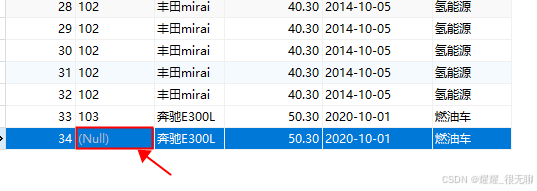
通过测试,看到程序并没有报错。正常执行。不过 #{kk} 的写法导致无法获取到map集合中的数据,最终导致数据库表car_num插入了NULL。
在以上sql语句中,可以看到#{k1} #{k2} #{k3} #{k4} #{k5}的可读性太差,为了增强可读性,我们可以将Java程序做如下修改:
|
1 2 3 4 5 6 7 |
Map<String, Object> map = new HashMap<>(); // 让key的可读性增强 map.put("carNum", "103"); map.put("brand", "奔驰E300L"); map.put("guidePrice", 50.3); map.put("produceTime", "2020-10-01"); map.put("carType", "燃油车"); |
SQL语句做如下修改,这样可以增强程序的可读性:
|
1 2 3 4 5 6 7 8 9 |
<?xml version="1.0" encoding="UTF-8" ?> <!DOCTYPE mapper PUBLIC "-//mybatis.org//DTD Mapper 3.0//EN" "http://mybatis.org/dtd/mybatis-3-mapper.dtd"> <mapper namespace="car"> <insert id="insertCar"> insert into t_car(car_num,brand,guide_price,produce_time,car_type) values(#{carNum},#{brand},#{guidePrice},#{produceTime},#{carType}) </insert> </mapper> |
运行程序,查看数据库表:

使用Map集合可以传参,那使用pojo(简单普通的java对象)可以完成传参吗?测试一下:
- 第一步:定义一个pojo类Car,提供相关属性。
|
1 2 3 4 5 6 7 8 9 10 11 12 13 14 15 16 17 18 19 20 21 22 23 24 25 26 27 28 29 30 31 32 33 34 35 36 37 38 39 40 41 42 43 44 45 46 47 48 49 50 51 52 53 54 55 56 57 58 59 60 61 62 63 64 65 66 67 68 69 70 71 72 73 74 75 76 77 78 79 80 81 82 83 84 85 86 87 88 |
package com.study.mybatis.pojo;
/** * POJOs,简单普通的Java对象。封装数据用的。 * @author sqnugy * @version 1.0 * @since 1.0 */ public class Car { private Long id; private String carNum; private String brand; private Double guidePrice; private String produceTime; private String carType;
@Override public String toString() { return "Car{" + "id=" + id + ", carNum='" + carNum + '\'' + ", brand='" + brand + '\'' + ", guidePrice=" + guidePrice + ", produceTime='" + produceTime + '\'' + ", carType='" + carType + '\'' + '}'; }
public Car() { }
public Car(Long id, String carNum, String brand, Double guidePrice, String produceTime, String carType) { this.id = id; this.carNum = carNum; this.brand = brand; this.guidePrice = guidePrice; this.produceTime = produceTime; this.carType = carType; }
public Long getId() { return id; }
public void setId(Long id) { this.id = id; }
public String getCarNum() { return carNum; }
public void setCarNum(String carNum) { this.carNum = carNum; }
public String getBrand() { return brand; }
public void setBrand(String brand) { this.brand = brand; }
public Double getGuidePrice() { return guidePrice; }
public void setGuidePrice(Double guidePrice) { this.guidePrice = guidePrice; }
public String getProduceTime() { return produceTime; }
public void setProduceTime(String produceTime) { this.produceTime = produceTime; }
public String getCarType() { return carType; }
public void setCarType(String carType) { this.carType = carType; } } |
- 第二步:Java程序
|
1 2 3 4 5 6 7 8 9 10 11 12 13 14 15 |
@Test public void testInsertCarByPOJO(){ // 创建POJO,封装数据 Car car = new Car(); car.setCarNum("103"); car.setBrand("奔驰C200"); car.setGuidePrice(33.23); car.setProduceTime("2020-10-11"); car.setCarType("燃油车"); // 获取SqlSession对象 SqlSession sqlSession = SqlSessionUtil.openSession(); // 执行SQL,传数据 int count = sqlSession.insert("insertCarByPOJO", car); System.out.println("插入了几条记录" + count); } |
- 第三步:SQL语句
|
1 2 3 4 |
<insert id="insertCarByPOJO"> <!--#{} 里写的是POJO的属性名--> insert into t_car(car_num,brand,guide_price,produce_time,car_type) values(#{carNum},#{brand},#{guidePrice},#{produceTime},#{carType}) </insert> |
- 运行程序,查看数据库表:
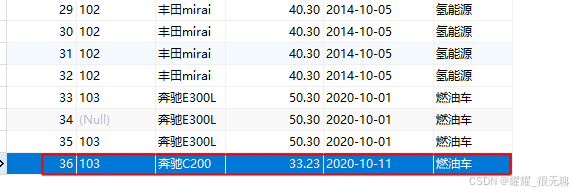
#{} 里写的是POJO的属性名,如果写成其他的会有问题吗?
|
1 2 3 |
<insert id="insertCarByPOJO"> insert into t_car(car_num,brand,guide_price,produce_time,car_type) values(#{a},#{brand},#{guidePrice},#{produceTime},#{carType}) </insert> |
运行程序,出现了以下异常:

错误信息中描述:在Car类中没有找到a属性的getter方法。
修改POJO类Car的代码,只将getCarNum()方法名修改为getA(),其他代码不变,如下:
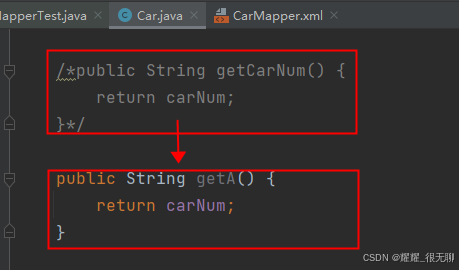
再运行程序,查看数据库表中数据:

经过测试得出结论:
如果采用map集合传参,#{} 里写的是map集合的key,如果key不存在不会报错,数据库表中会插入NULL。
如果采用POJO传参,#{} 里写的是get方法的方法名去掉get之后将剩下的单词首字母变小写(例如:getAge对应的是#{age},getUserName对应的是#{userName}),如果这样的get方法不存在会报错。
注意:其实传参数的时候有一个属性parameterType,这个属性用来指定传参的数据类型,不过这个属性是可以省略的
|
1 2 3 4 5 6 7 |
<insert id="insertCar" parameterType="java.util.Map"> insert into t_car(car_num,brand,guide_price,produce_time,car_type) values(#{carNum},#{brand},#{guidePrice},#{produceTime},#{carType}) </insert>
<insert id="insertCarByPOJO" parameterType="com.study.mybatis.pojo.Car"> insert into t_car(car_num,brand,guide_price,produce_time,car_type) values(#{carNum},#{brand},#{guidePrice},#{produceTime},#{carType}) </insert> |
2 delete(Delete)
需求:根据car_num进行删除。
SQL语句这样写:
|
1 2 3 |
<delete id="deleteByCarNum"> delete from t_car where car_num = #{SuiBianXie} </delete> |
Java程序这样写:
|
1 2 3 4 5 6 7 8 |
@Test public void testDeleteByCarNum(){ // 获取SqlSession对象 SqlSession sqlSession = SqlSessionUtil.openSession(); // 执行SQL语句 int count = sqlSession.delete("deleteByCarNum", "102"); System.out.println("删除了几条记录:" + count); } |
运行结果:

注意:当占位符只有一个的时候,${} 里面的内容可以随便写。
3 update(Update)
需求:修改id=34的Car信息,car_num为102,brand为比亚迪汉,guide_price为30.23,produce_time为2018-09-10,car_type为电车修改前:
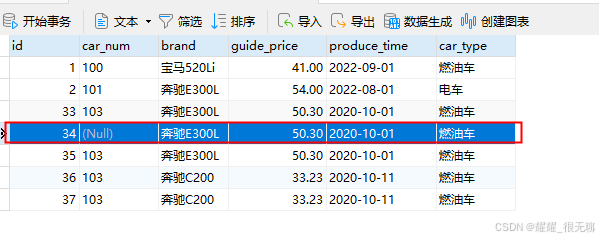
SQL语句如下:
|
1 2 3 4 5 6 7 |
<update id="updateCarByPOJO"> update t_car set car_num = #{carNum}, brand = #{brand}, guide_price = #{guidePrice}, produce_time = #{produceTime}, car_type = #{carType} where id = #{id} </update> |
Java代码如下:
|
1 2 3 4 5 6 7 8 9 10 11 12 13 14 15 16 |
@Test public void testUpdateCarByPOJO(){ // 准备数据 Car car = new Car(); car.setId(34L); car.setCarNum("102"); car.setBrand("比亚迪汉"); car.setGuidePrice(30.23); car.setProduceTime("2018-09-10"); car.setCarType("电车"); // 获取SqlSession对象 SqlSession sqlSession = SqlSessionUtil.openSession(); // 执行SQL语句 int count = sqlSession.update("updateCarByPOJO", car); System.out.println("更新了几条记录:" + count); } |
运行结果:


当然了,如果使用map传数据也是可以的。
4 select(Retrieve)
select语句和其它语句不同的是:查询会有一个结果集。来看mybatis是怎么处理结果集的!!!
查询一条数据
需求:查询id为1的Car信息
SQL语句如下:
|
1 2 3 |
<select id="selectCarById"> select * from t_car where id = #{id} </select> |
Java程序如下:
|
1 2 3 4 5 6 7 8 |
@Test public void testSelectCarById(){ // 获取SqlSession对象 SqlSession sqlSession = SqlSessionUtil.openSession(); // 执行SQL语句 Object car = sqlSession.selectOne("selectCarById", 1); System.out.println(car); } |
运行结果如下:
### Error querying database. Cause: org.apache.ibatis.executor.ExecutorException:
A query was run and no Result Maps were found for the Mapped Statement 'car.selectCarById'. 【翻译】:对于一个查询语句来说,没有找到查询的结果映射。
It's likely that neither a Result Type nor a Result Map was specified. 【翻译】:很可能既没有指定结果类型,也没有指定结果映射。
以上的异常大致的意思是:对于一个查询语句来说,你需要指定它的“结果类型”或者“结果映射”。
所以说,你想让mybatis查询之后返回一个Java对象的话,至少你要告诉mybatis返回一个什么类型的Java对象,可以在<select>标签中添加resultType属性,用来指定查询要转换类型:
|
1 2 3 |
<select id="selectCarById" resultType="com.study.mybatis.pojo.Car"> select * from t_car where id = #{id} </select> |
运行结果:

运行后之前的异常不再出现了,这说明添加了resultType属性之后,解决了之前的异常,可以看出resultType是不能省略的。
仔细观察控制台的日志信息,不难看出,结果查询出了一条。并且每个字段都查询到值了:Row: 1, 100, 宝马520Li, 41.00, 2022-09-01, 燃油车
但是奇怪的是返回的Car对象,只有id和brand两个属性有值,其它属性的值都是null,这是为什么呢?我们来观察一下查询结果列名和Car类的属性
名是否能一一对应:
查询结果集的列名:id, car_num, brand, guide_price, produce_time, car_type
Car类的属性名:id, carNum, brand, guidePrice, produceTime, carType
通过观察发现:只有id和brand是一致的,其他字段名和属性名对应不上,这是不是导致null的原因呢?我们尝试在sql语句中使用as关键字来给查
询结果列名起别名试试:
|
1 2 3 4 5 6 7 8 |
<select id="selectCarById" resultType="com.study.mybatis.pojo.Car"> select id, car_num as carNum, brand, guide_price as guidePrice, produce_time as produceTime, car_type as carType from t_car where id = #{id} </select> |
运行结果如下:

通过测试得知,如果当查询结果的字段名和java类的属性名对应不上的话,可以采用as关键字起别名,当然还有其它解决方案,我们后面再看。
查询多条数据
需求:查询所有的Car信息。
SQL语句如下:
|
1 2 3 4 5 6 7 8 |
<!--虽然结果是List集合,但是resultType属性需要指定的是List集合中元素的类型。--> <select id="selectCarAll" resultType="com.study.mybatis.pojo.Car"> <!--记得使用as起别名,让查询结果的字段名和java类的属性名对应上。--> select id, car_num as carNum, brand, guide_price as guidePrice, produce_time as produceTime, car_type as carType from t_car </select> |
Java代码如下:
|
1 2 3 4 5 6 7 8 9 |
@Test public void testSelectCarAll(){ // 获取SqlSession对象 SqlSession sqlSession = SqlSessionUtil.openSession(); // 执行SQL语句 List<Object> cars = sqlSession.selectList("selectCarAll"); // 输出结果 cars.forEach(car -> System.out.println(car)); } |
运行结果如下:
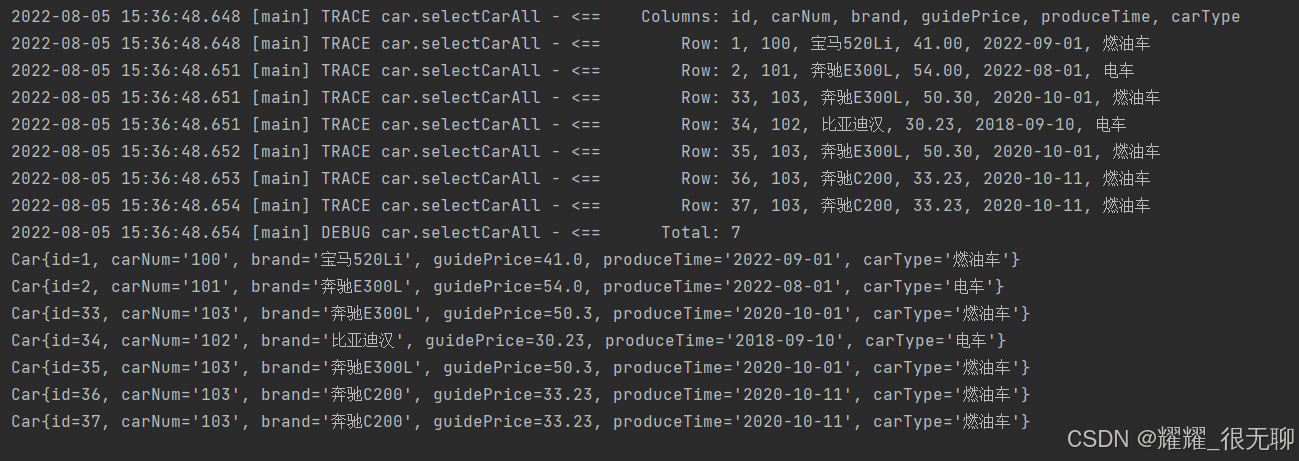
5 关于SQL Mapper的namespace
在SQL Mapper配置文件中<mapper>标签的namespace属性可以翻译为命名空间,这个命名空间主要是为了防止sqlId冲突的。
创建CarMapper2.xml文件,代码如下:
|
1 2 3 4 5 6 7 8 9 10 11 12 13 |
<?xml version="1.0" encoding="UTF-8" ?> <!DOCTYPE mapper PUBLIC "-//mybatis.org//DTD Mapper 3.0//EN" "http://mybatis.org/dtd/mybatis-3-mapper.dtd">
<mapper namespace="car2"> <select id="selectCarAll" resultType="com.study.mybatis.pojo.Car"> select id, car_num as carNum, brand, guide_price as guidePrice, produce_time as produceTime, car_type as carType from t_car </select> </mapper> |
不难看出,CarMapper.xml和CarMapper2.xml文件中都有 id="selectCarAll"将CarMapper2.xml配置到mybatis-config.xml文件中。
|
1 2 3 4 |
<mappers> <mapper resource="CarMapper.xml"/> <mapper resource="CarMapper2.xml"/> </mappers> |
编写Java代码如下:
|
1 2 3 4 5 6 7 8 9 |
@Test public void testNamespace(){ // 获取SqlSession对象 SqlSession sqlSession = SqlSessionUtil.openSession(); // 执行SQL语句 List<Object> cars = sqlSession.selectList("selectCarAll"); // 输出结果 cars.forEach(car -> System.out.println(car)); } |
运行结果如下:
org.apache.ibatis.exceptions.PersistenceException:
### Error querying database. Cause: java.lang.IllegalArgumentException:
selectCarAll is ambiguous in Mapped Statements collection (try using the full name including the namespace, or rename one of the entries)
【翻译】selectCarAll在Mapped Statements集合中不明确(请尝试使用包含名称空间的全名,或重命名其中一个条目)
【大致意思是】selectCarAll重名了,你要么在selectCarAll前添加一个名称空间,要有你改个其它名字。
Java代码修改如下:
|
1 2 3 4 5 6 7 8 9 10 |
@Test public void testNamespace(){ // 获取SqlSession对象 SqlSession sqlSession = SqlSessionUtil.openSession(); // 执行SQL语句 //List<Object> cars = sqlSession.selectList("car.selectCarAll"); List<Object> cars = sqlSession.selectList("car2.selectCarAll"); // 输出结果 cars.forEach(car -> System.out.println(car)); } |
运行结果如下:
